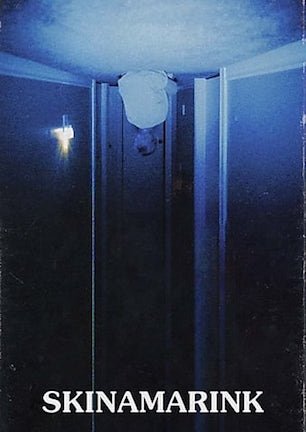Studio: IFC Midnight/Shudder
Director: Kyle Edward Ball
Writer: Kyle Edward Ball
Producer: Dylan Pearce
Stars: Lucas Paul, Dali Rose Tetreault, Ross Paul, Jamie Hill
Review Score:
Summary:
Two young siblings experience haunting supernatural phenomena after their parents inexplicably vanish inside their home.
Review:
There’s a reason why auto manufacturers put new vehicles through a strenuous series of safety protocols before mass-producing them to be sold on car lots. There’s a reason why food makers use taste tests to revise recipes prior to releasing new items to the public. There’s a reason why new medications aren’t immediately available in drugstores until after clinical trials have proven them to be effective and federal regulators have given their stamp of approval.
The reason is because unfinished prototypes have to undergo extensive preparation, responsible research, and focused tuning before they can be considered fit for commercial consumption. Movies, however, are beholden to no such standards. Entertainment may be the only industry where an experimental effort like “Skinamarink” can eschew preliminary quality checks and be distributed as a final product when what it really needs is more time in the lab to make sure it even works properly first.
Another thing about experiments is that they are driven by deliberate desires to create something specific or to prove or disprove a hypothesis. Can we do such and such? What’s inside of that? How will X react after introducing Y?
Other than a viewer’s patience, what exactly does “Skinamarink” set out to test that qualifies it as an “experimental” film? To see how fast someone can blow out a knee by kicking up a Road Runner cloud in the race to exit the theater early? To see which person in a viewing group will be first to reach for the remote’s Stop button? To see how much aimless abstractness masquerading as art one person can endure before triggering either of those two actions? I hadn’t even made it to the movie’s midpoint when I realized I’d already seen everything “Skinamarink” has to show, which isn’t much, and had already heard everything it has to say, which is nothing at all.
Someone else said IMDB describes “Skinamarink’s” plot more clearly than the film itself does, which I wish I’d thought to say first. “Skinamarink’s” entire “story,” or what cursorily counts as one, can be covered in a single sentence. Not simply summarized. Not just loglined. I mean the whole nebulous narrative’s beginning, middle, and end can be completely encapsulated in one sentence: “Paranormal activity plagues two siblings mysteriously trapped in their home after their parents inexplicably vanish.” Come to think of it, a question mark would be a better synopsis, and it’s shorter, something I wish this 100-minute exercise in tiresome surrealism was.
Here’s how a typical sequence in “Skinamarink” plays out: We see ten seconds of a ceiling fan spinning. The static camera then cuts to ten seconds of a dark doorway. Cut to ten more seconds of a different dark doorway. Cut to black. Cut to a flickering nightlight. Cut to another door. Cut to a lamp on a bedside table. Cut to toys scattered on a floor. Cut to a hallway. Cut to some carpet. Cut my throat and that would be a pain preferable to sitting through any more of this “movie.”
Half the time, it’s impossible to make out what’s onscreen because most of the footage is intentionally grainy or unintentionally muddy, and all of it is framed with the camera purposely in a poor position so it never points directly at a person, object, or action. Which leads to mentioning that while stream-of-consciousness plotting prevents enjoyment of “Skinamarink” as entertainment, there are no demonstrable filmmaking skills on display that warrant taking “Skinamarink” seriously as an artistic endeavor either.
It doesn’t take top-level talent to place a camera on the floor, leave a room unlit, and record half a minute of an empty outlet on a wall. Anyone can shine a flashlight on a clown-faced children’s toy in the dark and it will look vaguely eerie regardless of whose hand holds the beam. The “effect” used to make toilets and doorframes suddenly disappear is no more sophisticated than the janky jump cut “I Dream of Jeannie” used to blink things out of existence. Although it’s partly distorted to induce a particular effect, garbled audio becomes so bad that English subtitles appear even though spoken dialogue is also in English. Where is technical craftsmanship evident in any of this?
It certainly isn’t in a cutaway of a half-finished bowl of shredded wheat. There’s no symbolic metaphor imparting a message about hunger. There’s no deeper meaning about leaving something unfinished. It’s just an insert shot of cereal, randomly inserted without rhyme or reason because that’s what was immediately available during editing.
Maybe “Skinamarink’s” experiment was to see if it could con critics into convincing themselves that its tepid tedium was somehow terrifying. By that measure then, “Skinamarink” can be considered successful, as the film has earned admirers who attest to its supposed scariness, never mind that scares only come from inferring them for yourself when the camera lingers on an unmoving shadow, and lingers, and lingers, then cuts to another obnoxious public domain cartoon on TV.
Horror has one prominently divisive entry every year, and “Skinamarink” is definitely it for this 365-day cycle. When the next one comes around, I plan to avoid whatever it is like the proverbial plague because I never want to see anything like this ever again. A pointless piece of nonlinear nonsense, “Skinamarink” is a banal B-movie of boring B-roll that’s as drearily dull as any film can get.
Review Score: 15






It assumes everyone watching must be a dimwit too dense to understand how the most basic storytelling concepts work.